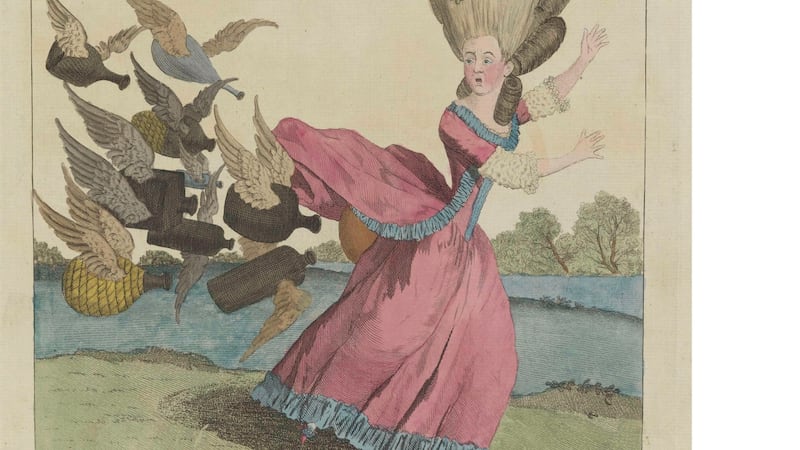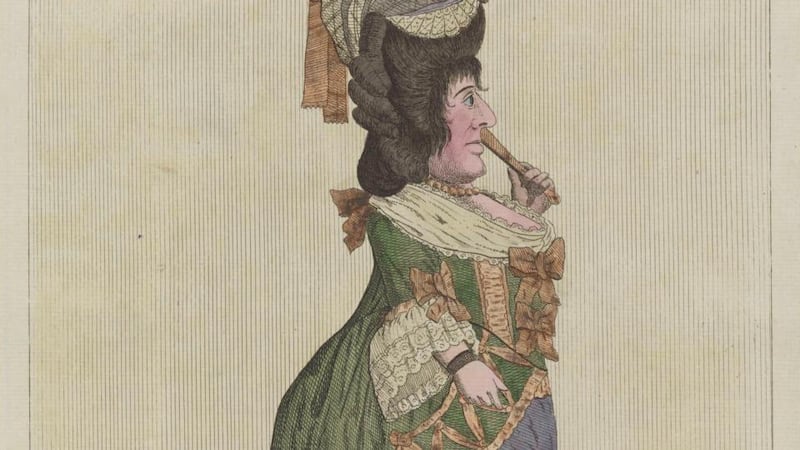Wicked Wit: Darly’s Comic Prints
Chester Beatty Library, Dublin
****


"An embarrassment of riches" is not a phrase that is bandied about much, but if you need to remind yourself what it means, visit the Chester Beatty Library. Reflect on the fact that what is on view is just a fraction of the collection.
As Dr Jill Unkel, curator of the latest exhibition there, says, Chester Beatty "assembled possibly the finest collection of manuscripts and printed books in private hands in the 20th century". She's been exploring one particular treasure from this trove: the comic images produced by husband-and-wife team Matthew (also Matthias) and Mary Darly, over a 15-year period from 1766, when they first opened their print shop at 39 The Strand in London.
Biographical details are scant, but the Darlys were both established artists and engravers prior to their marriage and professional collaboration. He was producing work in the early 1750s and sold it from another Strand premises, run with publishing partner George Edwards, from 1754.
In all likelihood Mary Darly ran her own shop from the latter half of the decade. In 1762 she advertised for an apprentice, Unkel writes, optimistically looking for "an ingenious, sober youth". That same year she published a book on the art of caricature drawing called A Book of Caricaturas.
Meticulously well made
They are thought to have married in the late 1750s, from when they began to work together, publishing their prints with the monogram “MD” or signed “MDarly”, which seems slightly iniquitous, but does distinguish their joint work from their individual efforts.
Their industry was considerable in terms of the range of services and products they offered, but also in the skilled, labour-intensive nature of the prints they produced, which were meticulously well-made and hand-coloured. This is all the more amazing given that, as satires and caricatures, they were ephemeral things in thrall to topicality. In the event, their popularity outlasted the moment, which might have more to do with their graphic quality than with their humour.
The Darlys were working in a rich tradition. For example, William Hogarth, the great painter, social critic and satirist, lived until 1764. Several of his most celebrated series of paintings, including A Harlot's Progress, A Rake's Progress and Marriage à-la-mode, gained widespread popularity as engravings, as did works conceived as prints, such as Gin Lane. The level of engraving expertise at the time was extraordinarily high, the production process incredibly streamlined, the public appetite enormous. Equally, for the Darlys, the pressure to produce was relentless.
Affected notions
Although the anecdotal detail in their work is specific to their time, the nature of the fashions and foibles they skewed remains constant. Many prints ridicule the “macaronis”, young men of privilege who embarked on the “grand tour” and arrived home with ludicrously affected notions of continental style and sophistication.
Women's fashions were also ripe for mockery, including the use of cork padding to accentuate the posterior, memorably satirised in the engraving The Siege of Cork. The most fertile subject was increasingly coiffures. In numerous accounts of the absurdity of hairstyles, elaborate constructions become fruit stalls, gardens and topiary. The images satirise, but they retain an exceptional integrity and beauty.
Caricatures – Mary’s speciality – are a fertile area, especially when linked to theatrical character. The Darlys tended to tread softly when it came to direct political commentary: the consequences of not doing so could be disastrous. There is evidence that Matthew had had a cautionary brush with censorial authority in the 1760s.
Most of the images encountered in th exhibition are based on drawings, or perhaps even just sketches, by others, including amateurs, not by the Darlys themselves.
In general terms, we can deduce the hand of Matthew or Mary in individual works in the light of their known individual interests. Mary was an accomplished caricaturist with a liking for social and political commentary. Matthew had a proven track record in ornamental and architectural areas. In fact he designed ceilings, furniture and more, besides applying himself to graphic work. It is noticeable that many of the interiors depicted in the prints are a delight in themselves, with a fine character.
Sadly, the Darlys hectic productivity came to an abrupt end in 1779, when an extensive quantity of their stock was advertised for auction. Unkel reckons “sudden illness may have forced MDarly to abruptly halt production”, because Matthew died in January 1780. Mary went on producing work on her own until at least March 1781, when her last-known print was published. Her fate is not known.
Over a single decade, Unkel writes, she and Matthew produced more than 500 images of exceptional quality. “At the height of their fame, carriages lined the streets so their occupants could titter at the images on display” in their exhibitions. In “every city and town in Great Britain and Ireland” booksellers sold their publications. They still have a great deal to offer.
- An illustrated publication, Wicked Wit: Darly's Comic Prints, by Jill Unkel, is available for €20. The exhibition runs until January 31st. cbl.ie












